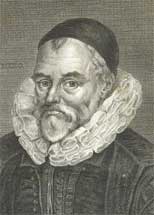Blaeu Atlas of Scotland, 1654
William Camden (1551-1623)
 As author of the famous Britannia..., the monumental work of late 16th century British chorography, William Camden had a significant influence on the Blaeu Atlas of Scotland. Camden is mentioned on Pont's manuscript map of South Uist, and given the publicity around Britannia in the 1580s, his work is likely to have influenced Timothy Pont in his chorographical and surveying activity. Through setting a new standard in chorographic writing, Britannia influenced the 17th-century contributors to Blaeu's Atlas, and the work also provides a substantial element to the Blaeu Atlas texts themselves.
As author of the famous Britannia..., the monumental work of late 16th century British chorography, William Camden had a significant influence on the Blaeu Atlas of Scotland. Camden is mentioned on Pont's manuscript map of South Uist, and given the publicity around Britannia in the 1580s, his work is likely to have influenced Timothy Pont in his chorographical and surveying activity. Through setting a new standard in chorographic writing, Britannia influenced the 17th-century contributors to Blaeu's Atlas, and the work also provides a substantial element to the Blaeu Atlas texts themselves.
William Camden was the son of a painter, and was born in London where he resided for most of his life. From 1566-1570 he studied at Oxford, where he made friends with several people who were to assist or encourage him in his later historical pursuits, such as Sir Philip Sydney, Richard and George Carew, and Sir John Packingham. In the 1570s he was fortunate in obtaining patronage from Dr Gabriel Goodman, Dean of Westminster and his brother Godfrey. Through them he was appointed second master of Westminster School from 1575. He taught at Westminster for the next 22 years.
After leaving Oxford, he extensively researched source material for Britannia, whilst also travelling around the country recording information. In 1578 he surveyed the county of the Iceni in Norfolk and Suffolk, whilst in 1582 his journeys took him to Yorkshire and Lancashire. In 1577 he is recorded as meeting Abraham Ortelius, (who had published his Theatrum Orbis Terrarum, credited with being the world's first conventional atlas, in 1570). In 1579, Camden corresponded with Gerard Mercator over Antonine's itineraries. Britannia was first published in May 1586 to widespread acclaim, with three further editions within four years; a fourth edition came out in 1594. The work was a substantially more detailed geographical description than that of Leland or other contemporaries, combining history, linguistics, genealogy and etymology. In its emphasis on the contemporary social order, and the distinguished historical roots of regions, places and people, it became an important patriotic work, helping the English to define themselves. Camden relied on a widespread network on compilers, including William Lambarde, Humphrey Llwyd, Sampson Erdeswick, and Sir Robert Cotton, who contributed their own descriptions of counties to the work.
Camden was appointed Clarenceux king-of-arms in 1597, a post he held until his death. This allowed him to continue travelling and to research further information to augment the Britannia. He also wrote several other works, amongst which were an account of the trial of the Gunpowder Plot (1605) and a history of Queen Elizabeth's reign until 1588 (1615). The 6th (1607) edition of the Britannia, the last before Camden's death, was published in a larger folio size, with substantial additions, including maps of several counties by Christopher Saxton and John Norden, and a single map of Scotland. It is from this edition that the texts for Blaeu's Atlas of Scotland derive.
Camden died in 1623 and was buried at Westminster Abbey, but the Britannia continued in its popularity for the next two centuries, with new editions translated into English and with substantial additions. Edmund Gibson's 1695 edition of Britannia with English text, includes Timothy Pont's description of the Antonine Wall (through Robert Sibbald), and in 1789 the antiquarian Richard Gough was to issue a three-volume edition with even greater additions.
